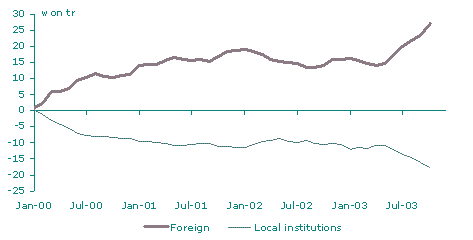Kuroto Fund, L.P. - Q3 2003 Letter
Dear Partners and Friends,
Performance
Like most equity investors around the globe, we benefited from the liquidity driven investment surge during the third quarter of 2003. Unlike most equity investors around the globe, we can still accurately claim that our shares remain undervalued. Our portfolio of stocks currently trades for less than seven times next year’s estimated earnings and provides a dividend yield in excess of five percent.
What Do The Locals Know?
One surprising feature of the Asian version of the recent global surge in stock prices is the reluctance of most local investors to participate. The Japanese stock market, for instance, has risen thirty-seven percent from its first quarter lows. Despite this, Japanese investors remain persistent sellers. Likewise, in India, foreigners have been large net purchasers of Indian stocks, while local funds remain net sellers. Even more perplexing is the accelerating rate at which Korean investors have been selling local shares. Foreigners have more than absorbed the local Korean selling pressure and still driven KOSPI up almost thirty percent this year. But despite the good market performance, the local Korean brokers we spoke to during a recent trip to Seoul remain pessimistic.
Cumulative Net Buying of Korea Stock Exchange Listed Stocks
“…the divergence between foreign and local (Asian) investors’ activity has of late been remarkable, if not unprecedented.” (Chris Wood of CLSA)
In the aftermath of a traumatic market experience, it is often those closest to the situation that are the last to recognize a change of direction. Recall that after decades of rising interest rates, America’s premier bond house, Saloman Brothers, sold out on the very eve of the greatest bond bull market in history. Similarly, the managements of many gold mining companies had been so negative on the prospects for their product that they were actively selling the precious metal short at the very bottom of its two decade long bear market. In Asia today, the locals remain fixated on the obvious problems of the past while ignoring the region’s current extraordinary rates of economic growth and the bright future prospects for Asian equities.
Projected Real GDP Growth
2003 2004
China 8.7% 9.5%
Hong Kong 2.5% 6.0%
India 7.1% 6.0%
Indonesia 3.8% 5.3%
Korea 2.5% 6.0%
Malaysia 4.9% 6.1%
Philippines 3.6% 4.0%
Singapore 0.9% 5.8%
Taiwan 3.3% 5.8%
Thailand 6.2% 8.0%
Source: Goldman Sachs & UBS
Asian interest rates are the lowest in memory, the region has seen real improvement in corporate governance, many local banking systems have been restructured, corporate balance sheets have been strengthened, and local investors remain unduly pessimistic. Though we are reluctant to use the term, we admit to being “bullish” on Asia.
Asia’s Consumer Boom Favors Kuroto’s Strategy
Asians are “embarking on a consumption and lifestyle boom that strongly echoes the American Baby Boomer era. Only bigger.” (Gary Coull of CLSA)
“’These days who wants to save?’ asks the young bank clerk hurrying between jewelry shops during her lunch break at MBK shopping mall in Bangkok… After decades of stashing away their savings, Asia’s rapidly growing middle classes are turning into voracious consumers.”[1] This new consuming class is driving “a revolution in Asia that is likely to transform global spending patterns.”[2] As owners of established consumer brands and dominant consumer franchises, Kuroto Fund is positioned to benefit from the burgeoning of an Asian consumer class.
Asians’ disposable income levels are low but rising quickly--thereby providing them the incremental buying power to rapidly increase their consumption of non-essential goods. Furthermore, Asian households’ balance sheets are in especially good shape. After generations of very high rates of savings, a mere decline in those rates to more normal levels will foster a substantial incremental increase in consumption. Asia’s demographics also support growing consumption. Their youthful population, accelerating household formation, and declining household size call to mind America’s demographic situation thirty years ago. Finally, younger Asian’s relatively liberal attitudes about consumption and credit contrast sharply with their parents’ parsimony.
Economic progress driven by the consumption aspirations of younger Asians, opposed to Asia’s export driven growth of the second half of the twentieth century, will help to reduce the region’s dependence on world economic conditions. This change in Asia’s appetite for consumption could form the basis for a significant alteration of global capital flows. If the large-scale movement of savings from the thrifty East to spendthrift America turns out to be unsustainable, there are profound implications for world capital markets. At the very least, such a change would sever Asian stock markets’ correlation with Wall Street. It might also result in a meaningful long-term upward revaluation of the Asian securities in which Kuroto is invested.
[1] Financial Times October 2003
[2] Financial Times October 2003
Sincerely,
Sean Fieler
William W. Strong










